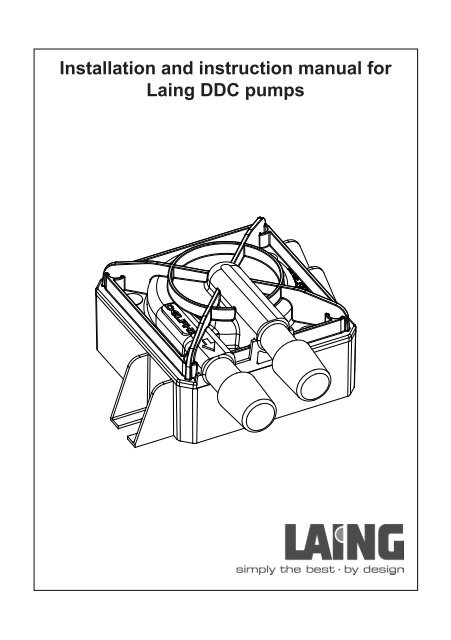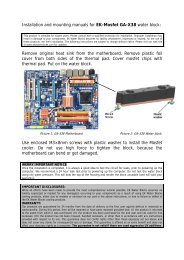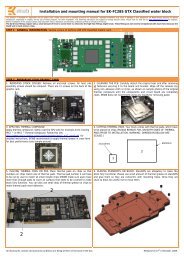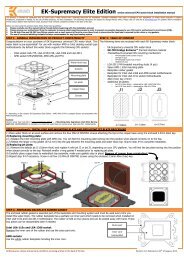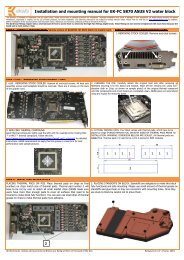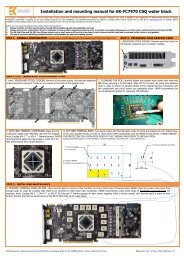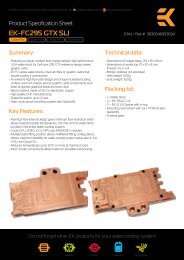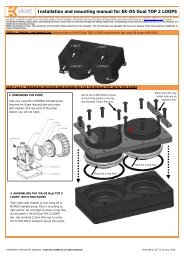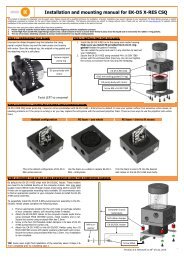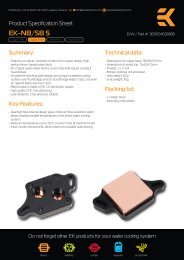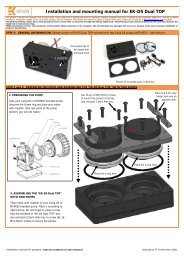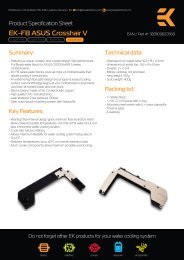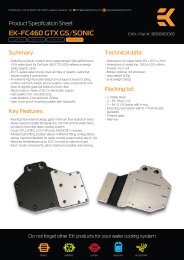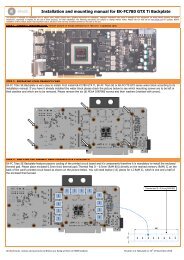Installation and instruction manual for Laing DDC pumps
Installation and instruction manual for Laing DDC pumps
Installation and instruction manual for Laing DDC pumps
You also want an ePaper? Increase the reach of your titles
YUMPU automatically turns print PDFs into web optimized ePapers that Google loves.
<strong>Installation</strong> <strong>and</strong> <strong>instruction</strong> <strong>manual</strong> <strong>for</strong><br />
<strong>Laing</strong> <strong>DDC</strong> <strong>pumps</strong>
<strong>Installation</strong> <strong>and</strong> <strong>instruction</strong> <strong>manual</strong> <strong>Laing</strong> <strong>DDC</strong> <strong>pumps</strong><br />
Application<br />
The <strong>Laing</strong> <strong>DDC</strong> series <strong>pumps</strong> are primarily used <strong>for</strong> the circulation of cooling<br />
liquid in liquid cooled computers.<br />
Construction<br />
- The <strong>Laing</strong> <strong>DDC</strong> <strong>pumps</strong> are spherical motor <strong>pumps</strong>, which provide very<br />
quiet operation <strong>and</strong> long life.<br />
- The motor is electronically commutated <strong>and</strong> the <strong>pumps</strong> consequently<br />
have a high efficiency.<br />
- The electronic commutation creates a sine wave voltage, practically<br />
eliminating commutation noises.<br />
- The <strong>DDC</strong> pump is supplied with mounting feet <strong>and</strong> either 3/8“ hose barb<br />
(models <strong>DDC</strong>-1, <strong>DDC</strong>-1 P <strong>and</strong> <strong>DDC</strong>1- T)or 1/4’“ male thread connections<br />
(models <strong>DDC</strong>-1 R, <strong>DDC</strong>-1 RP <strong>and</strong> <strong>DDC</strong>1- RT)<br />
- <strong>DDC</strong>-1: Pump with lead wire, no connector.<br />
- <strong>DDC</strong>-1P: Pump with hard disk power connector.<br />
- <strong>DDC</strong>-1T: Pump with hard disk power connector <strong>for</strong> power <strong>and</strong> an<br />
additional fan connector <strong>for</strong> the tacho output. If this connector is plugged<br />
into a fan receptacle on the motherboard, the rpm of the pump can be<br />
monitored in the BIOS.<br />
Expansion tank<br />
<strong>Installation</strong><br />
Fan<br />
- The pump is ideally in<br />
stalled in the cooling loop<br />
Heat exchanger<br />
be<strong>for</strong>e the air cooled heat<br />
Cold Plate<br />
exchanger. In this way, the<br />
waste heat of the pump<br />
itself is added to the<br />
cooling loop downstream<br />
of the CPU<br />
- An expansion tank needs<br />
to be mounted on the<br />
suction side of the pump. The expansion tank must be sized such that<br />
there is always sufficient liquid in the system.<br />
<br />
www.laing.de
<strong>Installation</strong> <strong>and</strong> <strong>instruction</strong> <strong>manual</strong> <strong>Laing</strong> <strong>DDC</strong> <strong>pumps</strong><br />
- The pump must be mounted<br />
below the level of an open<br />
expansion tank.<br />
- Ideally the pump should be<br />
placed at the lowest<br />
point of the system.<br />
- The pump is mounted on a<br />
flat surface. Avoid bending the<br />
pump by over tightening of<br />
the screws.<br />
Drilling dimensions <strong>for</strong> the mounting holes<br />
<strong>Installation</strong> position<br />
The pump can be mounted either to a wall or on the bottom of the computer.<br />
The pump must not be mounted with the motor pointing up <strong>and</strong> it must not<br />
be installed pumping downwards.<br />
www.laing.de
<strong>Installation</strong> <strong>and</strong> <strong>instruction</strong> <strong>manual</strong> <strong>Laing</strong> <strong>DDC</strong> <strong>pumps</strong><br />
Electrical connection<br />
− The <strong>DDC</strong> pump runs on 12 Volt DC. If you install a pump without<br />
connector, make sure to observe the correct polarity.<br />
− <strong>DDC</strong>-1P <strong>and</strong> <strong>DDC</strong>-1T are equipped with a connector <strong>for</strong> the power<br />
supply.<br />
− The fan connector of the <strong>DDC</strong>-1T can be plugged into a fan receptacle<br />
on the motherboard to enable monitoring of the pump rpm.<br />
Start-up<br />
− The cooling loop must be fully operational be<strong>for</strong>e starting the computer<br />
because the CPU otherwise can overheat in a very short time <strong>and</strong> can<br />
suffer damage.<br />
− Be<strong>for</strong>e starting up the pump make sure that the loop is completely filled.<br />
− Start the pump<br />
− If you can hear an audible noise, air is left in the pump. Switching the<br />
pump on <strong>and</strong> off several times can accelerate the purging of this air.<br />
Disconnect the power plug <strong>and</strong> reconnect it after approx. 2 seconds.<br />
− While purging the air observe the liquid level in the expansion tank. If<br />
the liquid in the expansion tank is exhausted, air will be sucked back<br />
into the loop continuously.<br />
− If the system does not run quiet after several minutes of purging stop<br />
the pump <strong>and</strong> re-fill the system.<br />
− Avoid running the pump dry <strong>for</strong> prolonged periods since this will damage<br />
the bearing.<br />
<br />
www.laing.de
<strong>Installation</strong> <strong>and</strong> <strong>instruction</strong> <strong>manual</strong> <strong>Laing</strong> <strong>DDC</strong> <strong>pumps</strong><br />
Maintenance<br />
− The pump does not require any maintenance. There are no user<br />
replaceable parts in the pump.<br />
− It is important <strong>for</strong> trouble free operation of the pump that there is always<br />
enough liquid in the pump, since dry run damages the bearing <strong>and</strong> leads<br />
to reduced flow or interruption of the pumping operation.<br />
− Air in the system will cause audible noise <strong>and</strong> there<strong>for</strong>e can be easily<br />
detected.<br />
− If there are <strong>for</strong>eign particles or deposits in the system, please follow the<br />
<strong>instruction</strong>s listed in the troubleshooting section.<br />
Troubleshooting<br />
− If the pump does not operate,<br />
please check first whether the<br />
power supply is operating<br />
correctly.<br />
− If this does not resolve the<br />
problem please unplug the<br />
pump several times.<br />
− If this still does not result in<br />
the pump starting, it is<br />
probably blocked by particles<br />
or deposits in the system.<br />
− Drain the system <strong>and</strong> remove<br />
the pump.<br />
− Open the pump by removing<br />
the four housing screws at<br />
the bottom.<br />
− Remove the pump housing <strong>and</strong><br />
pull out the rotor.<br />
− Clean the rotor <strong>and</strong> the stator<br />
with a clean cloth <strong>and</strong> purge<br />
all dirt from the pump housing.<br />
Pump<br />
housing<br />
Rotor<br />
Seal ring<br />
Stator<br />
Housing<br />
screws<br />
www.laing.de
<strong>Installation</strong> <strong>and</strong> <strong>instruction</strong> <strong>manual</strong> <strong>Laing</strong> <strong>DDC</strong> <strong>pumps</strong><br />
− After reinserting the rotor into the stator per<strong>for</strong>m a brief run test to make<br />
sure that the rotor is spinning up. Caution: To avoid the introduction of<br />
water into the electronics the pump should be completely dry be<strong>for</strong>e this<br />
test is done.<br />
− If the rotor is spinning in the above test, remove the o-ring from its seat<br />
<strong>and</strong> clean it carefully.<br />
− Re-insert the seal ring, place the pump housing on top of the motor <strong>and</strong><br />
screw it in place using the four screws.<br />
− If the pump still won’t work or if the rotor does not run during the run test<br />
the pump needs to be replaced.<br />
Dimensional drawing (in mm)<br />
<br />
www.laing.de
<strong>Installation</strong> <strong>and</strong> <strong>instruction</strong> <strong>manual</strong> <strong>Laing</strong> <strong>DDC</strong> <strong>pumps</strong><br />
Pump curve<br />
Pump head [m]<br />
Power consumption [W]<br />
Flow rate [l/h]<br />
www.laing.de
About us<br />
Since the 1950s we at <strong>Laing</strong> have worked in the areas of research,<br />
development <strong>and</strong> production of <strong>pumps</strong> <strong>and</strong> heating products. The original<br />
R&D institute located in Southern Germany has over the years evolved into<br />
an international company with additional locations in the US, Japan <strong>and</strong><br />
Hungary <strong>and</strong> with more than 400 employees.<br />
Today, our program consists of:<br />
• Pumps (Shaftless spherical motor <strong>pumps</strong>) • Heating controls<br />
• Floor heating system connection • Electrical heaters<br />
• Special products<br />
We are a flexible <strong>and</strong> competent partner in the area of pumping <strong>and</strong><br />
heating. We invite you to try our high quality, economic products.<br />
<strong>Laing</strong> GmbH · Systeme für Wärmetechnik<br />
Klingelbrunnenweg 4 · 71686 Remseck · Germany Phone: +49(0) 7146/93-0<br />
Fax: +49(0) 7146/93-33 · E-Mail: info@laing.de · Internet: www.laing.de<br />
261007 Subject to change withot notice


